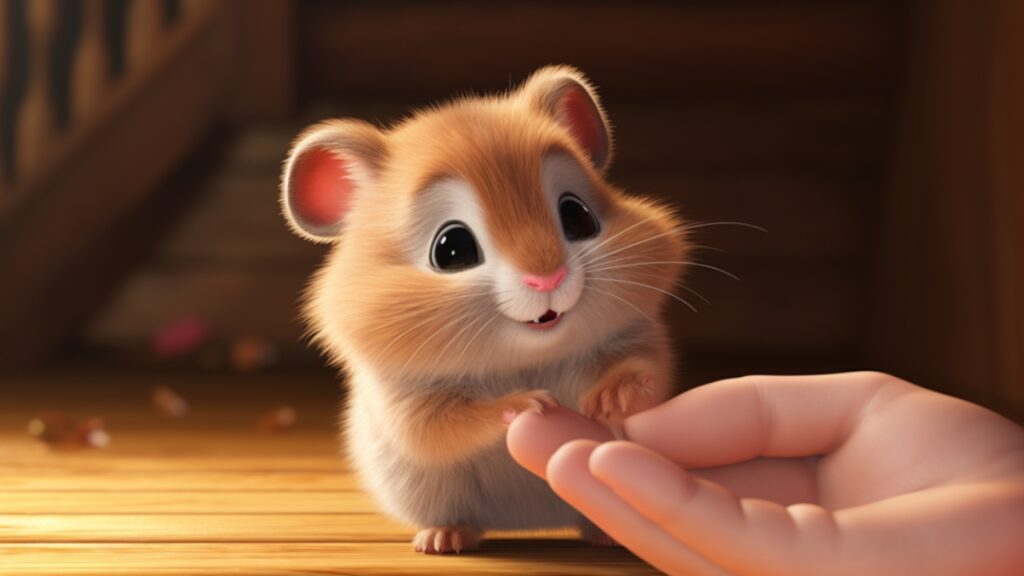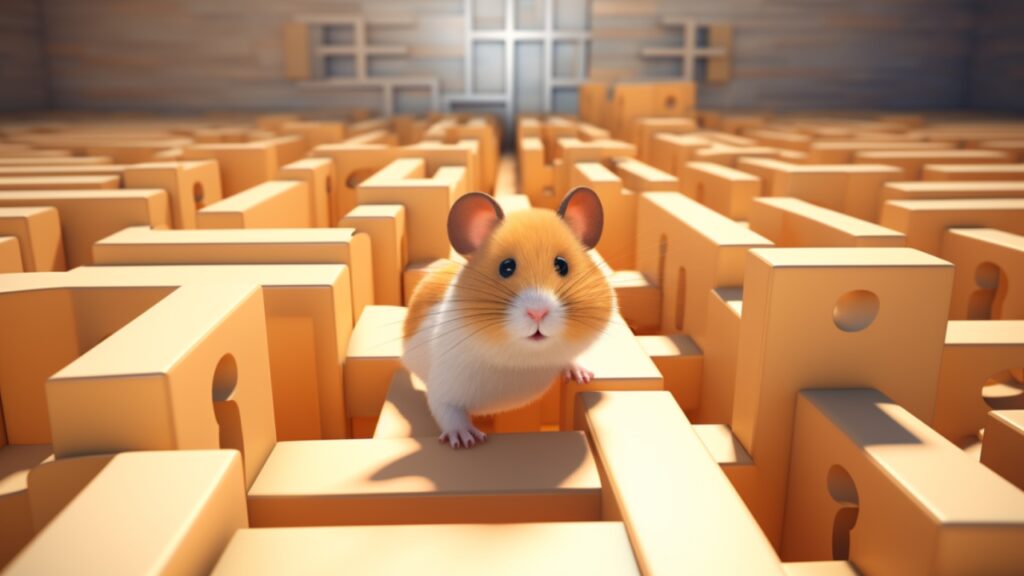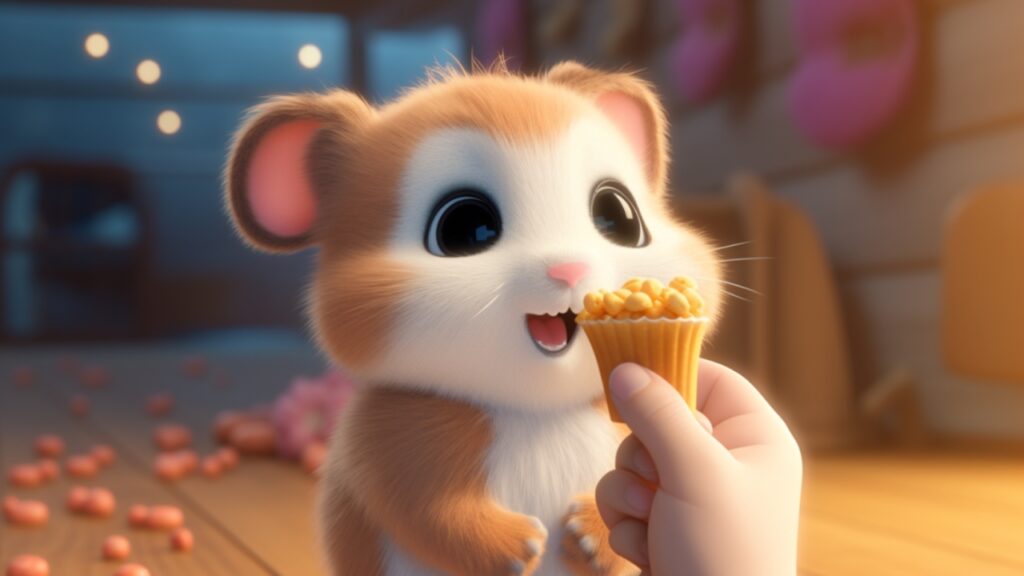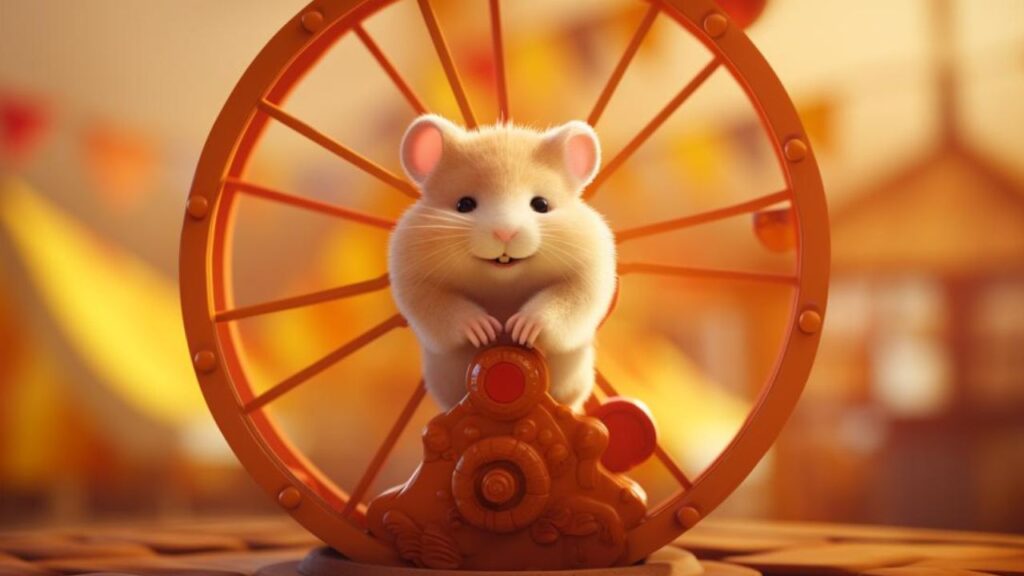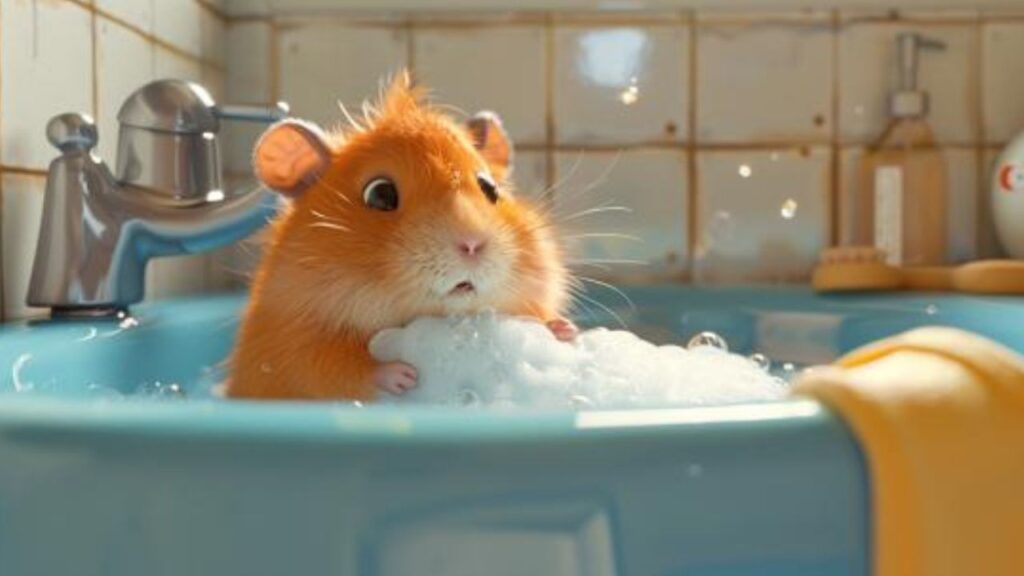Hello there, fellow hamster enthusiasts! As we stand on the cusp of transforming our little furballs into the epitome of patience, it’s vital to understand the ‘whys’ before we jump into the ‘hows’. Why do hamsters, nature’s tiny explorers, behave the way they do? Why does their world seem to be in fast forward while ours lingers in play mode? Let’s unravel these mysteries together and get a step closer to mastering the heartwarming art of ‘stay’. After all, every great training journey starts with understanding, and who better to guide you through this than your neighborly expert? Buckle in, grab a cozy blanket (perhaps your hamster’s already snuggled in one!), and let’s get started!
Why ‘Stay’ Matters: The Nuanced Dance of Hamster Stillness ✋
Ah, the elusive moment when your hamster takes a break from its usual scurry, looks up with those shiny eyes, and stands perfectly still. It’s a sight to behold! But have you ever wondered why teaching your hamster to ‘stay’ is more than just a cute trick? It’s a sign of trust, comfort, and an indication of the bond you share with your tiny friend. Getting a naturally active creature like a hamster to pause, even for a fleeting moment, requires understanding, patience, and trust from both sides of the cage. It’s akin to getting a toddler to sit still during their favorite cartoon—challenging, but oh-so rewarding when achieved. By fostering the skill of ‘stay’, you’re not just taming a behavior; you’re building a bridge of understanding with your pet.
Breaking Down the Hamster Hustle: The Constant Motion of Tiny Furballs
So, why are hamsters always on the go? Let’s dive into the hustle and bustle that is a hamster’s life. These little creatures are hardwired for movement. In the wild, they’re on a constant lookout for food, potential threats, or perhaps an appealing mate. Their tiny hearts, beating away at a rapid rate, push them to explore, dig, and dash about. But it’s not all about survival; it’s also about curiosity. The world is a gigantic puzzle for hamsters, with each corner holding potential secrets. Every scent, sound, and texture is a new chapter in their ever-curious book of life. So when we talk about training your hamster to stay still, we’re essentially asking them to resist their natural instincts, pause their busy little lives, and trust us enough to stay put. It’s a tall order, but with the right techniques and a sprinkle of patience, it’s entirely achievable!
So, dear reader, buckle up (or should I say, ‘fasten your fur’?). We’re about to embark on a journey to unlock the secrets behind the art of ‘stay’ and help you become the Hamster Whisperer you’ve always dreamt of being.
The Science Behind the Scurry
When observing our lively little fur friends, we might often wonder why they seem to have an unending supply of energy, always darting around with zest and zeal. However, interspersed with their natural zest for zipping around, there are those precious moments when they pause, standing still as a statue. As puzzling as it might seem, there’s a method to this ‘madness’, a delicate dance between nature and nurture, survival, and safety. So, grab your notepads, fellow Hamster Whisperers, as we delve into the intriguing science behind your hamster’s scurry and stillness!
Rodent Restlessness
Hamsters, by their very nature, are little balls of energy. Always on the move, always exploring, and always curious. But have you ever paused to ponder why? The origins of this behavior are rooted deep in their wild ancestry. In the wild, constant movement means scavenging for food, escaping predators, and simply surviving. This intrinsic need to keep moving has been passed down through generations, making our domestic pals the scurrying aficionados they are today. Their tiny, rapid heartbeats (averaging a whopping 300-500 beats per minute!) are a testament to their high metabolic rate and energy levels. Their world, in essence, is a fast-paced race against time.
Stillness as Safety
Now, while movement is a dominant trait, these little critters do have their moments of tranquility. Sometimes, standing absolutely still is a hamster’s way of blending into the background, becoming invisible to potential threats. It’s their version of “If I can’t see you, you can’t see me.” In the wild, a sudden halt might mean they’ve sensed a predator. At home, it might indicate that they’re unsure about their surroundings or even trying to discern if that new toy you introduced is friend or foe. This stillness can, therefore, be seen as a defense mechanism—a brief pause in their perpetual motion to ensure safety.
Let’s dive in deeper and see how we can harness this natural behavior for some bonding and training!
The Pathway to Patience
You know, every time I sit down with my cup of tea and watch my hamster friends frolic around, it reminds me of a dance—sometimes fast and frenzied, other times slow and still. But here’s the tea (pun intended ☕): Training a hamster isn’t all that different from teaching a dance. It’s all about understanding their rhythm, establishing trust, and guiding them step by step. Much like any long-lasting relationship, the hamster-human bond is built on a foundation of trust. And if you’re aiming for your furry friend to “stay” on cue, patience is your best partner. So, let’s shimmy our way through this dance, shall we?
Building Trust
Trust is the choreography of any relationship, and it’s no different when it comes to our hamster pals. Before you even think of training them, it’s vital to establish a rapport. It’s the silent dialogue where they recognize you’re not a predator but a friend. And how do we do this? Start with slow interactions, like gentle talking or offering treats from your hand. Remember, trust isn’t built in a day—it’s a gradual process. ❤️
Steps to Stillness
Now that you’ve got your hamster’s trust, it’s time to take baby steps towards achieving stillness. Start by holding your hand flat in their enclosure, letting them explore and stand on you. Gradually, using a soft voice command like “stay”, reward them for longer periods of stillness with their favorite treat. Consistency is key. With time, practice, and lots of positive reinforcement, your little furball will begin to associate the “stay” command with a tasty reward and respond accordingly. Remember, it’s a dance, and every dancer has their own pace. Celebrate the small victories and keep grooving forward!
Natural vs. Nurtured Behavior: ❓
Peeling back the layers of our hamster friends is a delightful blend of art and science. Their tiny squeaks, zoomies around the cage, and even their sudden pauses speak volumes. It’s a tale of evolution , mixed with the daily comforts or challenges they encounter. So, whether it’s an instinct from eons ago or something they’ve just picked up, let’s decode it! ️♀️
Inborn Instincts:
Hamsters have been around long before they became our favorite cheek-stuffing buddies. Born in the wild, their ancestors had their fair share of adventures and close calls.
- The Foraging Frenzy: Ever noticed your hamster’s cheeks looking like they’re about to burst? This isn’t just them being gluttonous. Nature taught them to grab and store for uncertain times.
- Sprint, Stop, Sprint: ♂️♂️ Those energetic dashes and pauses aren’t them training for the ‘Hamster Olympics’. It’s all about survival – run from threats, and freeze to blend in!
- Night Owls: ✨ Does your hamster love the nightlife? It’s not a party phase; it’s an instinct! Nighttime escapades kept them safe from daytime predators.
While some behaviors can be mildly influenced, understanding and respecting these natural rhythms is the secret sauce to a content hamster.
The Role of Environment:
Our pet hamsters might not be in the wild, but they sure have a connection to it! The mini universe we design for them is a canvas of experiences, a space where they can be themselves.
- Space and Freedom: A spacious cage = a happy hamster. It’s their playground, their world. Give them room to roam, and watch the magic happen!
- Toys, Tunnels, and More: New toys or tunnels? It’s like Christmas morning for them! These toys are more than just playthings; they’re snippets of their wild habitats.
- Safety First: ️ Our furry pals need to feel safe. A secure environment, free from looming threats (like that curious cat ), keeps them at ease.
In the grand scheme of things, each choice we make, from the size of the cage to the treats we give, paints their world . And the right strokes lead to a blissful hamster symphony!
Common Setbacks and Solutions:
Ah, the joys of hamster parenting! As we’ve seen, hamsters come with their quirks and personalities, some quite entertaining and others… well, let’s call them challenges. If you’ve ever thought, “Why won’t Mr. Whiskers just chill for a second?!” or “Did that doorbell just send him on a marathon?”, you’re in the right place. Let’s dive into some common hamster hiccups and how to navigate them like a pro.
The Overly Eager Explorer: ️
If your hamster seems to have two speeds—fast and ludicrous speed—you’ve got an explorer on your hands. Here’s how to manage that insatiable curiosity:
- Interactive Toys: Invest in some maze-like toys and tunnels. They’ll satiate the inner Indiana Jones in your hamster and give you some moments of respite.
- Safe Play Zones: ️ Create a hamster-proofed area where your little explorer can safely roam outside the cage. Remember, it’s about redirecting that energy, not suppressing it.
- Routine Playtimes: ⏰ Just like us, hamsters benefit from a routine. Set designated exploration times. Over time, they’ll associate that period with adventure and be more calm otherwise.
Remember, exploration is a natural hamster trait. The goal is to channel it in safe and fun ways!
Sound Sensitivities:
Your hamster’s ears are like super-powered radar dishes. A creaky door or a blaring TV can be distressing. Here’s how to help:
- The Soundproofing Hack: Consider placing their cage in a quieter part of your home. Sometimes, it’s as simple as moving them to a spot away from high traffic or noisy appliances.
- Background Noise: Playing soft background sounds like white noise can help mask sudden loud noises. It’s like a comforting blanket for their ears!
- Awareness is Key: Familiarize everyone at home about your hamster’s sensitivity. Little actions, like not slamming doors or lowering the volume, can make a big difference.
Understanding their sensitivities and making small adjustments can transform your home into a serene sanctuary for your furry friend. ️
Hannah’s Training Tactics: ✨
Oh, my fellow hamster enthusiasts! Training our little furballs can seem like rocket science sometimes, can’t it? But, with the right tactics up your sleeve, you’ll have your hamster listening to you (well, most of the time) in no time! Let’s dive deep into some of my tried-and-true strategies.
Trust Treats:
Just as we humans love our little indulgences (hello, chocolate chip cookies! ), our hamsters have their own list of favorites. Every time they show a hint of the behavior you’re training for, reward them immediately with a treat. This rapid reinforcement creates a powerful association: “remain still = yummy treat.”
- Timely Treats: ⏱️ The key here is timing. Offer that treat immediately after they follow the command, even if it’s just for a split second. Over time, they’ll increase their stillness duration for that delectable prize.
- Variety’s the Spice of Life: Rotate between a few hamster-approved treats to keep things interesting and avoid overfeeding a particular treat.
Vocal Cues and Consistency: ️
Your voice is a tool—make it count! Hamsters, with time, can learn to recognize certain words or the tone of your voice.
- Clear Command: Choose a simple and consistent phrase for the ‘stay’ command. It could be a soft “Stay…” or “Easy…”. Whatever you pick, stick with it.
- Tone Matters: Use a gentle, soothing tone. Hamsters are more likely to react to the mood in your voice than the actual words.
The Power of Touch:
Touch is a universal language, and with hamsters, it can be a source of comfort and reassurance.
- Gentle Gestures: ️ Start with slow and soft touches. If your hamster is comfortable, you can gently place a hand over them (without pressing down) to encourage stillness.
- Warm Palms: Sometimes, placing your warm hand near your hamster can be a calming presence. They might just snuggle right in!
- Remember Their Personal Space: Always be respectful. If they seem uncomfortable or stressed, give them space and try again later.
Training a hamster, just like any relationship, requires patience, understanding, and, of course, a sprinkle of fun. Use these tactics, and remember: each hamster is unique. What works wonders for one might require tweaks for another. Keep experimenting and enjoying the journey. With paws and patience, you’re on the road to being a Hamster Whisperer. Happy training! ❤️
The Ultimate Stillness Quest:
Ah, the grand finale! You’ve journeyed through the whys and hows, understood the natural inclinations of our tiny friends, and even practiced some hands-on tactics. As we tie everything together, it’s essential to remember the significance of what you’re aiming for. Training your hamster isn’t just about mastering commands; it’s about forging a bond that’s built on trust, understanding, and mutual respect. And like all good things in life, the best results come from consistency, patience, and a sprinkle of love. Let’s wrap things up with a reflection on the beauty of the training journey and the road ahead. ️
The Stillness Success Story:
Every little moment your hamster chooses to remain still, even if it’s just a fleeting second, is a cause for celebration! Let’s be real, getting an energetic and naturally curious creature to halt in its tracks is no small feat. Cherish these tiny victories; they’re proof of your bond strengthening and your training efforts bearing fruit. And remember, every big achievement starts with the decision to try. Your hamster’s brief pause today might just evolve into extended moments of stillness tomorrow. ➡️
The Journey Ahead: ️
Hamster training isn’t a one-and-done deal. It’s a continuous journey of understanding, adapting, and growing together. As seasons change and hamsters age, their behaviors and needs may shift. It’s vital to stay adaptable, observant, and, most importantly, patient. Training is as much about the process as it is about the outcome. Relish the journey, cherish the shared moments, and always strive to deepen that beautiful bond with your furry friend. ❤️
With paws and patience, you’re on the road to being a Hamster Whisperer. Happy training!



